It is the template for many books, films and games of our time: Norse mythology. However, it is not a standardised religion or cultural practice. If you want to get an overview of the origins, history and content of the Scandinavian mythology, you’ve come to the right place.
Important Scandinavian gods
- Odin/Wodan– father of the gods, god of war
- Thor/Donar– god of thunderstorms and weather
- Loki – Asian god, role disputed
- Heimdall – Guardian of the Bifrost
- Hel – ruler of the realm of the dead
- Freya – goddess of love and marriage
- Freyr/Frey/Yngvi– ancestor of the Swedish kings
- Balder – god of light
What does Norse mythology mean?
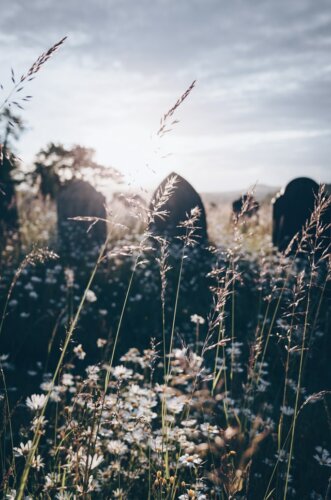
Norse mythology refers to the entire world of legends of the peoples living in present-day Scandinavia before Christianisation. This means that it does not refer to a uniform religion, as we understand the term today. As the area of Scandinavia is large and was neither linguistically nor culturally homogeneous, the rites and beliefs differed locally. There are also rare sources in Germanic languages.
This is why there are often different versions of gods’ names, which can be seen, for example, in the famous gods Odin and Thor, who were called Wodan and Donar in Germanic. It must also be remembered that, unlike the Catholic and Protestant churches, there was no institution that defined the world of the gods and how they were practised.
Nordic guardian spirits and gods
Research today assumes that paganism can be divided into two areas: The belief in guardian spirits and gods. It was assumed that guardian spirits lived in special places in nature or appeared in the form of animals, while gods were supposed to appear in human form.
History of the Nordic religions
2200-800 BC: Bronze Age
1500-1300 BC: first sources for shamanic rituals
The first sources documenting the practice of sun and fertility cults can be found as early as 1500-1300 BC. They provide clues as to what the early pre-Christian culture in the Scandinavian countries might have looked like. There are rock carvings from this period that have survived the test of time.
1500-1000 BC: cremation
Another reference to religious practices is cremation, which is said to have been carried out in the second millennium BC. It is assumed that it served to free the soul from the body and prepare it for life in the afterlife. Sources include urn finds from this period.
1000 BC - 800 AD: different sources
400 BC: ship burials
A change in burial practice can be observed around 400 BC. People, especially those who belonged to a higher class, were buried in their full costume on a ship full of valuable gifts. As in ancient Greece, coins were often placed in the mouth of the deceased, possibly to pay for the “passage” to the afterlife.
0-100 AD: first written sources
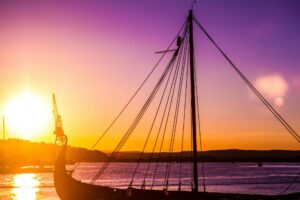
The first written sources can be found in the first century A.D. The descriptions of the Roman historian Tacitus are particularly noteworthy in this context. However, the votive stones of Germanic soldiers have also been handed down and often contain short messages.
5th century AD: oldest depiction of the Midgard Serpent in Lyngby
The oldest known depiction of the Midgard Serpent, a snake lying around the world and biting its own tail, comes from a medallion from the 5th century AD, which was found in Lyngby. Other depictions can also be found in the 8th and 12th centuries, for example.
6th century A.D.: tradition of Procopius
Another important source comes from the historian Prokop, who described in the 6th century AD that the inhabitants of what is now Norway worshipped gods and spirits in nature and were connected to them in an important sacrificial tradition. Ares, or Tyr, is named as the highest god. It is therefore assumed that he could be a predecessor of Odin.
800-1300 AD: Skalds and Icelandic sagas
From 900 AD: Scaldic poetry and establishment of the warrior class
It is assumed that a large part of the world of myths only emerged from the 9th century AD onwards. This is due to the fact that many myths originate from Skaldic poetry and the warrior class. According to historical research, the latter only developed from the 9th century onwards. However, it is also assumed that many of the elements that were taken up were already circulating before then, as the earlier sources show.
900-1000 AD: early mentions in Icelandic sagas

The first Icelandic sagas mentioned figures from Norse mythology as early as 1000 AD. The Egils saga from 934 AD is particularly noteworthy. It contains a curse that names Odin, Frey and Njörd. The Skírnismál, a song of the gods from the Song Edda, also contains curses that invoke Odin, Thor and Frey.
13th century AD: the famous Eddas
Particularly famous Icelandic sagas are the “Elder Edda”, the “Song Edda” and, based on this, Snorri Sturluson’s “Snorra Edda” or “Prose Edda”. Much of what is assumed today about Norse mythology comes from the Snorra Edda. However, it should be noted that it dates from a time when Christianity had already been widespread in Scandinavia for around 200 years. The famous family feuds described in the Edda also date from two centuries before it was written. It is therefore not possible to say with certainty how accurately the Snorra Edda reflects mythological practice.
Christianisation of Scandinavia
1000-1300 AD: process of Christianisation
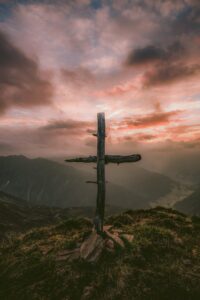
The Christianisation of the Scandinavian population largely took place in the period 1000-1300 A.D. The process began in Denmark and spread via Norway and Sweden to Iceland. Although individual kings such as Hákon I and Óláfr I Trygvasson and Óláfr II from Norway are attributed particular importance, trade and cultural relations between the Scandinavian countries and with the countries of Central Europe also played an important role. The influence of Celtic slaves, who were involved in child-rearing among other things, is also considered an important factor in research.
Sources: How do we know what Norse mythology looked like?
The sources from which we know today what Norse mythology looked like come only in part from archaeological artefacts. The translation of Old Norse runes, the so-called Icelandic sagas (Icelandic term for certain stories from the Middle Ages) and Roman historiography also provided us with knowledge about the gods and worlds.
What was actually handed down was more likely to come from skalds at the royal court. It is therefore not entirely clear to what extent the ideas were widespread among the population and which gods were worshipped and how.
The Snorra Edda
Another source that is often consulted is the so-called Snorra Edda. The author, Snorri Sturluson, was an Icelandic poet of the 12th century who wrote some of today’s most important Old Norse sources.
These include the so-called Song Edda. For this reason, the Edda, which we use as a source for matters of Norse mythology, is often referred to as the Prose Edda in order to differentiate it. The motivation for this is said to have been to preserve Norse myths, as Snorri feared that they could be lost through the Christianisation of the North.
We should bear in mind that the Snorra Edda is not an exact description of what people believed or practised in their everyday lives. Instead, you will find more skaldic lore here. However, it is precisely this that forms the basis for what we know about Norse mythology today.
Practising pagan customs in Scandinavia
It is difficult to determine exactly what was practised and how it related to the mythology that has come down to us today. Even though artefacts have been found that are said to date back to the Bronze Age, it has not yet been possible to conclusively determine which entities were worshipped at what time.
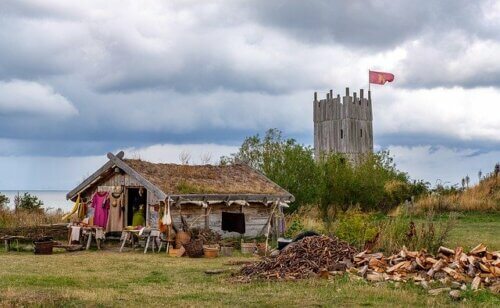
It is assumed that shamans practised and that at times there was a lively fertility cult, which also included offerings.
So-called votive stones, i.e. stones dedicated to deities or honoured personalities, have also been found. However, their inscriptions are so short and often incomprehensible without prior knowledge that they are often not good sources for historical research.
There are local and social differences. Take Iceland, for example: it is assumed that Thor was worshipped by farmers in particular as the god of thunder, fertility, rain and wind. Freyr was worshipped by Icelandic farmers and was supposed to watch over livestock, especially horses and pigs. However, Odin, who is now considered the father of the gods, is said not to have been worshipped at all in Iceland.
Worlds: from Midgard to Hel
The mythical world was divided into nine worlds that were inhabited and ruled by different beings. The world of the gods and the mortals were connected by a bridge. This rainbow bridge was called Bifröst.
Below you will find some important worlds of Norse mythology:
Midgard: the world of men
Midgard is the world in which humans live. It is surrounded by a sea, the World Sea, in which the so-called Midgard Serpent lives. If you were to draw a map, Midgard would be at the centre, with the other worlds spread out around it.
Asgard: the world of the gods
Asgard is home to the gods, more precisely the race of the Aesir. This world is divided into different areas, which are ruled by different gods.
The realm of the dead Hel
The realm of the dead lies beneath the human world and is guarded by Hel, the goddess of death. Her upper body is that of a beautiful woman, while her lower body is merely a skeleton. This symbolises the transience of all life.
Jötunheim and Utgard: the world of the giants
Utgard is home to giants and all sorts of evil creatures waiting to attack on Ragnarök, the day of the battle of gods against men.
Ragnarök
The term Ragnarök comes from Old Norse and means something like “fate of the gods”. It refers to the prophecy of the end of the world, which originates from the poem Völuspá, written around 1000 AD. It consists of a three-year battle between the gods and the giants and the three-year Fimbulwinter before the world finally comes to an end.
Other important places and events in the mythical world
- Vanaheimr: home of the Vanir dynasty of gods
- Ljosalfheim (also Álfheimr): home of the Light Elves and presumably of Freyr
- Svartalfheim: home of the dwarves and nature spirits
- Muspelheim: realm of fire in the south
- Niflheim: Ice world in the north
- Yggdrasil, the Tree of Life, also known as the World Ash: a tree that spreads across all nine worlds and symbolises their entirety
- Valhalla: destination of all warriors after their death. Here they wait and train together with Odin for the day of Ragnarök.
- Ragnarök: the end of the world, triggered by the battle between gods and giants. Afterwards, however, a new world is to emerge.
Gods and other mythical beings
The Aesir: the warlike race of gods
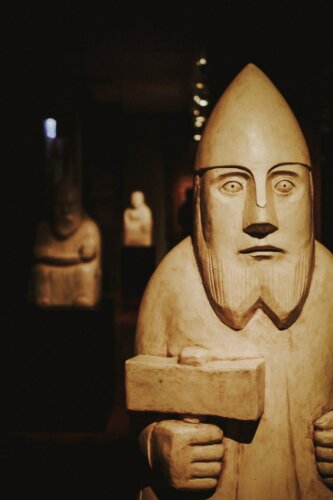
The Asen are the younger race of gods and are characterised in the Snorra Edda as warlike and strong.
They lost the war against the Wanen, but gained equal rights and sent Hönir, Odin’s constant companion, to the Vanir as an assurance of peace.
They are not immortal, but keep themselves young with the help of the goddess Iðunn, who is responsible for immortality and youth.
Which gods belong to the Asen?
- Odin/Wodan: the father of the gods, god of war and the dead
- Frigg: Odin’s wife
- Thor/Donar: the god of thunderstorms and weather
- Loki: negative role in Ragnarök, but original role disputed
- Hel: the goddess of the underworld
- Heimdall: the bridge keeper of Bifröst
- Saga: the goddess of poetry
The Wanen: Gods of fertility and prosperity
Although the Vanir won the battle against the Asen, they agreed to equal rights. In an exchange of hostages after the Vanir War, they sent the twins Freya and Frey, as well as the sea god Njörðr to the Asen. Their home is Vanaheimr and they were primarily sung as gods of fertility and prosperity. They are also immortal if they are not killed.
Which gods belong to the Wanen?
- Freyr: ancestor god of the Swedish kings, stands for peace and fertility
- Freya: the goddess of love, marriage and fertility
- Njörðr: the god of wind and the sea
Museums of Norse mythology and history
If you want to learn more about Norse mythology and history, we recommend the following museums in Scandinavia, which have permanent exhibitions.
- Danish National Museum Copenhagen
- Viking Museum Stockholm
- Historiska Museet Stockholm
- Historisk Museum Oslo
- Snorrastofa Reykholt
In German-speaking countries, the Neues Museum in Berlin, for example, gives you the chance to marvel at the impressive murals of Norse mythology. The Haithabu Viking Museum in Schleswig is also worth a visit.
Sources:
https://de.wikipedia.org/wiki/Nordische_Mythologie
Líndal, Sigurður (2011): Eine kleine Geschichte Islands. Berlin: Suhrkamp Taschenbuch Verlag.
Tuchtenhagen, Ralph (2008): Kleine Geschichte Schwedens. München: Verlag C.H. Beck.